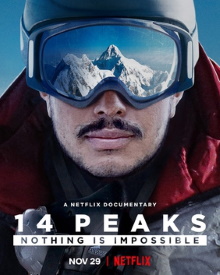I was a little hesitant to watch this because on the surface it feels like it’s just another mountaineering documentary so why watch more of the same. What makes this particular project interesting to me is that it was conceived and led by a Nepali Nirmal Purja with a team of fellow Nepali climbers. As such it’s a deliberate attempt to move away from the old tradition of Westerners leading mountain expeditions and the Nepali sherpas being credited only as assistants. I also appreciated that this film, unlike so many others, actually goes into the difficulty of raising money in the pursuit of such an insane dream, on top of the physical and mental challenges of the climbing itself.
The documentary kicks off directly with Purja and his team climbing Annapurna in Nepal. They are instrumental in encouraging and helping teams reach the summit, a pattern that would recur in other ascents. After descending, they hear of another climber who had been stranded and spent the night on the mountain. They decide to ascend again to rescue him despite their exhaustion and the danger to themselves. In between the climbing scenes, the film backfills with the story of their project to climb the 14 highest mountains on Earth within seven months as well as Purja’s personal background. Born in Nepal, he aimed for and succeeded in joining first the Gurkhas and later the UK’s Special Boat Service, in the process becoming a naturalized British citizen. After realizing that he has a natural ability to excel at the low oxygen levels of high altitudes, he decides to leave the military and pursue a career as a mountaineer. He launched this project to prove himself as well as make a statement on behalf of Nepalis despite having to mortgage his house in England to provide initial funding.
The main draw of most mountaineering documentaries are the spectacular scenery from some of the highest and most inaccessible places on the planet. This film offers plenty of great visuals as Purja and his team summits so many mountains but it has little time to devote to each of them and even differentiating between them is a problem for us casuals. So the focus moves instead to some of the most dramatic incidents during this seven-month period as well as the life story of Purja himself. The team attempts to help other climbers on multiple occasions, Purja himself experiences a fall that could easily have been fatal and he has to organize a campaign to persuade China to allow them to climb the last of the 14 peaks, Shishapangma. Purja’s life too is fascinating, being a soldier coming from a family of other soldiers who is obsessed with achieving the peak of physical fitness.
The film also goes into Purja’s devotion to his mother which is less interesting to me but it does seem heartfelt and exposes how this project was a terrible financial risk to his extended family. It seems that his salary as an elite British soldier was enough to assure financial security for his whole family even back in Nepal and in addition to his own life, he has put his personal wealth on the line as well. Though the film doesn’t explicitly say so, obviously once he had some initial success, he managed to obtain more funding. I do like how it shows that Purja doesn’t just have to be a near-superhuman climber. He had to be a salesperson and organizer as well to persuade others to invest in his dream and attract enough followers to be interested in his journey.
Reading up more on the events, the documentary does skip over some details, especially the unpleasant parts. For instance, the man that they helped rescue on Annapurna was actually a Malaysian who subsequently died in Singapore. In fact, if I understand things correctly, every single one of the lost climbers they stopped to help ended up dying, which rather rams home the point how incredibly dangerous this is. Yet for Purja himself, including ascents made after this project, he has summited Mount Everest no less than six times. As my wife noted, these are people for whom the hardest mountains in the world are too easy so the only way left for them to increase the difficulty level is to pile on so many peaks. The stated time limit of seven months even understates the difficulty. Most of that is due to the need to schedule around weather windows for particular mountains. When they actually do climb, they tackle multiple peaks within a matter of days, which is an insane level of physical effort. I do note that Purja seems to have been the only member of the team to summit all 14 peaks as part of the project. The other members took turns which is only sensible.
All in all, this was another documentary that I really enjoyed, less for the climbing adventure itself than for the biography of the kind of person who could set out to accomplish such a project and succeed at it. I note that Purja is not a naturally charismatic speaker and sometimes flails at finding words that sound good. This to my mind enhances its authenticity as it is really Purja who is speaking and this wasn’t made according to a script. I don’t really like the idea of this inspiring people. It is definitely one of those don’t try this at home kids lessons instead. But I do like this as a showcase of the unimaginable diversity of people, of their wildly different capabilities, mindsets and lifestyles and that is all good in my book.
